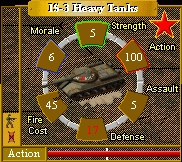
Game Statistics

|
| Victory Points |
Armour | Start | Start | End | End | ||
| Front | Side | Rear | Month | Year | Month | Year | |
| 8 | 36 | 14 | 13 | 4 | 45 | 5 | 45 |
| IS-3 Heavy Tank | ||||||||||||||||||||
| RANGE | 1 | 2 | 3 | 4 | 5 | 6 | 7 | 8 | 9 | 10 | 11 | 12 | 13 | 14 | 15 | 16 | 17 | 18 | 19 | 20 |
| HARD | 44 | 40 | 36 | 32 | 28 | 24 | 18 | 14 | . | . | . | . | . | . | . | . | . | . | . | . |
| SOFT | 18 | 18 | 17 | 17 | 16 | 15 | 14 | 13 | 12 | 11 | 11 | 10 | 10 | 9 | 9 | 8 | . | . | . | . |
History
|
|
|
Specification |
|
The new "Kirovets-1" heavy tank project commenced in summer 1944. This project was undertaken after a detailed examination was performed of the types and locations of battle damage inflicted by German antitank weapons on Soviet armored vehicles. There were, in fact, two different heavy tank projects being developed under two competing engineering groups: one group led by J.Y. Kotin and A.S. Ermolaev, and the other group led by N.L. Dukhov and M.F. Baldji.
The first project was based on Objects #244, #245, and #248. The main feature of this project was the unusual frontal armor (glacis). It consisted of two plates welded at an angle, which sloped down from the center on both sides. Designers called this feature a "pike's nose", while western sources call it simply a "Pike."
All previous tanks had flat frontal armor built from a single plate. The old version had two crewmen at the front of the tank: the driver and the radio operator. By removing the radio operator's position, the driver could be relocated to the center. This allowed the tank designers to reconfigure the sides of the glacis, creating two sloping "cheek-bones." The sloping armor reduced the tank's weight and essentially strengthened the hull from the front. Moreover, it was hoped that the sloping geometry would withstand enemy fire better. |